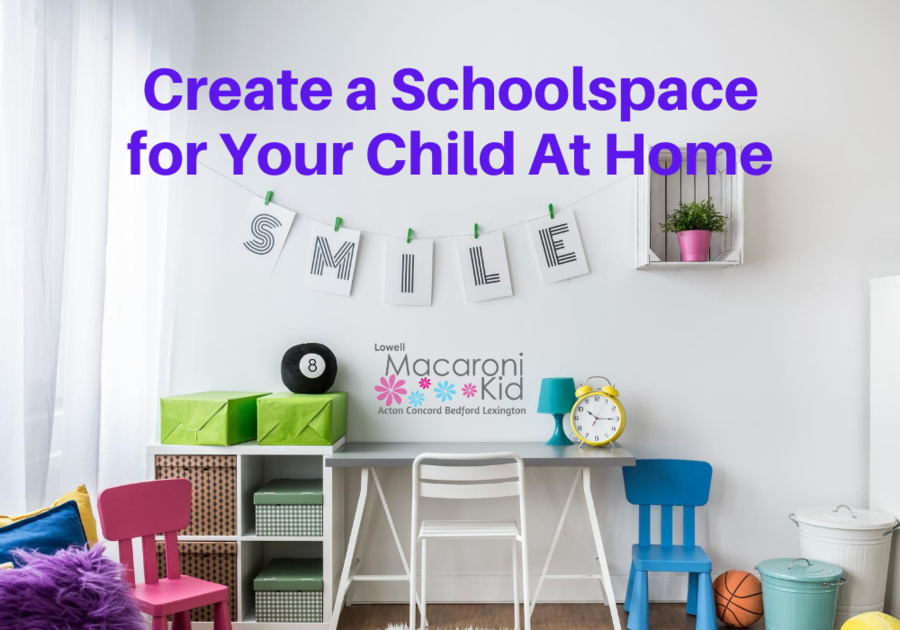Whether you've chosen hybrid or 100% remote learning for your child, you will need a workspace ~ or "schoolspace" ~ at home where they can focus on their lessons and complete their schoolwork. Some homes have enough room for a separate schoolspace for each child, complete with their own desk. But perhaps your home is on the small side, and a schoolspace will necessarily be a temporary space, set up during the day, and put away at night. I've tried to include ideas to help create a space that will work in most homes and with most budgets. Thank you to local moms for sharing their ideas, suggestions and photos!
What Will Your Child Need to Do in Their Schoolspace?
First, think about what your child will need to do for school at home. Depending on grade level, your child will do some or all of the following in their schoolspace:
- Listen to online lessons, without distractions
- Take notes
- Complete worksheets or print a report (Do you have a printer at home or have you figured out a way to get printouts locally? Check the library and local copy shops. Many will take files via email and hold the printouts for you to pick up.)
- Calculate
- Write out answers to math, English, foreign language questions
- Submit photos or a PDF of their completed handwritten work
- Organize and use school supplies, such as pens, ruler, compass, charts, math cards, etc.
- Read books
- Write or color
- Assemble or glue
- Do an oral presentation online
Remember, It's a Work in Progress
Your schoolspace doesn't have to be perfect for the first day of school. Nail down the most important elements -- a Chromebook/laptop/device for your child, a surface to write on, notebooks and pens. As you and your child see what kind of activities will be required, you can adjust, decorate, and improve your setup as you go.
Be sure to involve your child in the process as you create their schoolspace. They will be more likely to use the space and will love their special nook if it contains decorations and items that they picked out.
Together or Separate?
Before designing your schoolspace, think back to the Spring when we had remote learning. If you have more than one child, did they do their school work in the same space? Was it too noisy? Did they fight or distract each other? Should they be separated or will they be OK in the same space? If you and/or your partner have a work-from-home space, is it feasible and/or advisable to share that space with your child or do you need separate spaces?
Feng Shui
Feng Shui is a Chinese philosophy focused on placing your furniture and other elements to optimize energy flow. It sounds silly but I embrace this philosophy at home. In particular, make use of available natural light and air flow. Don't place the desk up against a wall, since looking at a wall may close your mind off from the flow of ideas. If possible, place a desk or a portable schoolspace with a view of a window, a door or a larger space. My work desk is in the middle of our office/playroom, facing the rest of the room and the entry door, with a good view of three brightly-lit windows. A wall and bookcases are behind and beside me. I love how open it is (please excuse the messy desk!).
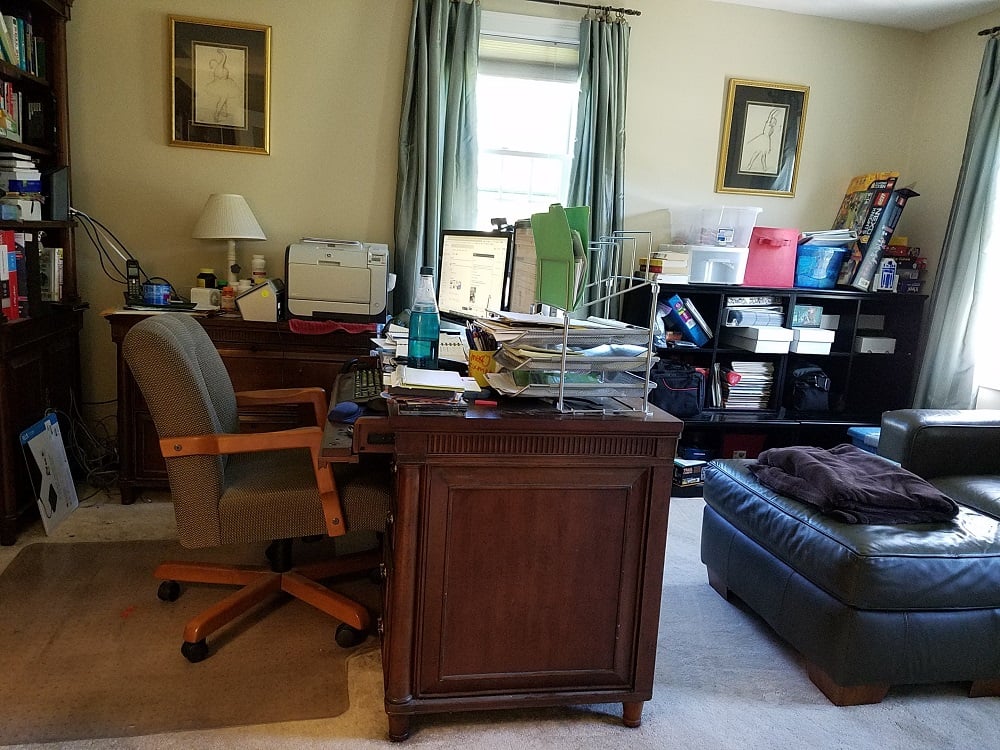
Credit Barbara Evangelista
Shared Space Ideas
If your home doesn't have enough space to set up desks for the kids, then try setting up a shared space at a dining room table if you have one (since dining room tables never seem to be used!) or at the kitchen table if there's no dining room. To encourage kids to focus on their own work and reduce distractions, create a schoolspace divider for each child using a tri-fold poster board. See examples and learn the process in this popular YouTube video by Angelina Harper. Kids can decorate with stickers and markers to create their own special space.
Alternatively, perhaps a lap desk will work for your child, to use on the couch, floor, bean bag, reading chair or even in bed? (I'd certainly need to monitor my teens to make sure they don't fall asleep if they choose to do school work in bed!) There are many options available, including a medium size desk on adjustable legs to a smaller version with built-in mousepad and lap cushion.
Individual Desk Ideas
If you do have the space at home to add desks for the kids, there are tons of options to consider.
Cheri Pasciuto recommends a sturdy folding table (available at Target, Walmart, Home Depot or Lowes for around $50) as a great option that will fit into most spaces. You can even put it right in front of a bookcase; the shelf space behind it can be used to store bins of school supplies. Try to get a folding table with adjustable legs if you have young students so that you can set the table height lower.
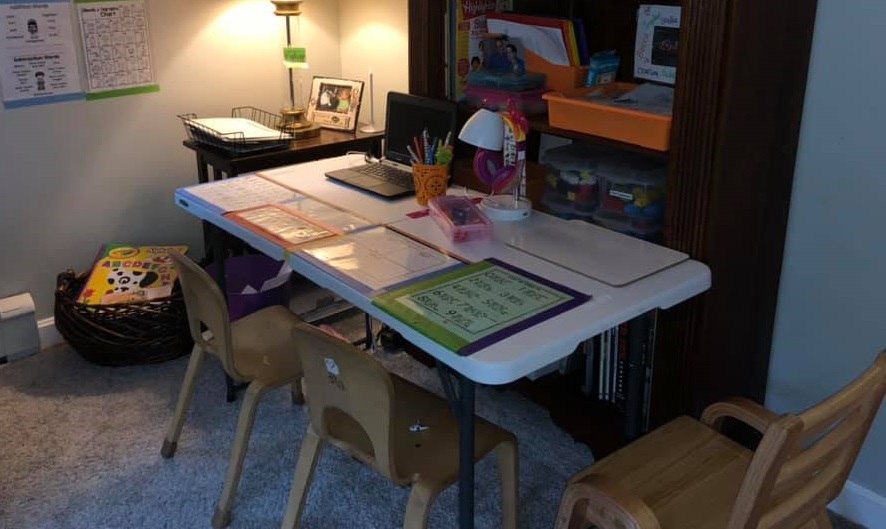
Credit Cheri Pasciuto
Brittney Effler recommends this simple yet attractive collapsible desk -- take the top off and fold the sides in, and the whole setup can be tucked away when needed. Here's another very simple desk, although it's not collapsible.
IKEA specializes in very simple and inexpensive desk options -- one option for only $25 is the LINNMON table top with ADILS legs. According to the IKEA website, this desk is currently in stock at Stoughton. Be sure to check again before you drive all the way there though!
Joanne de Vries recommends the MICKE desk if you need a really small desk. She's created a great little schoolspace.
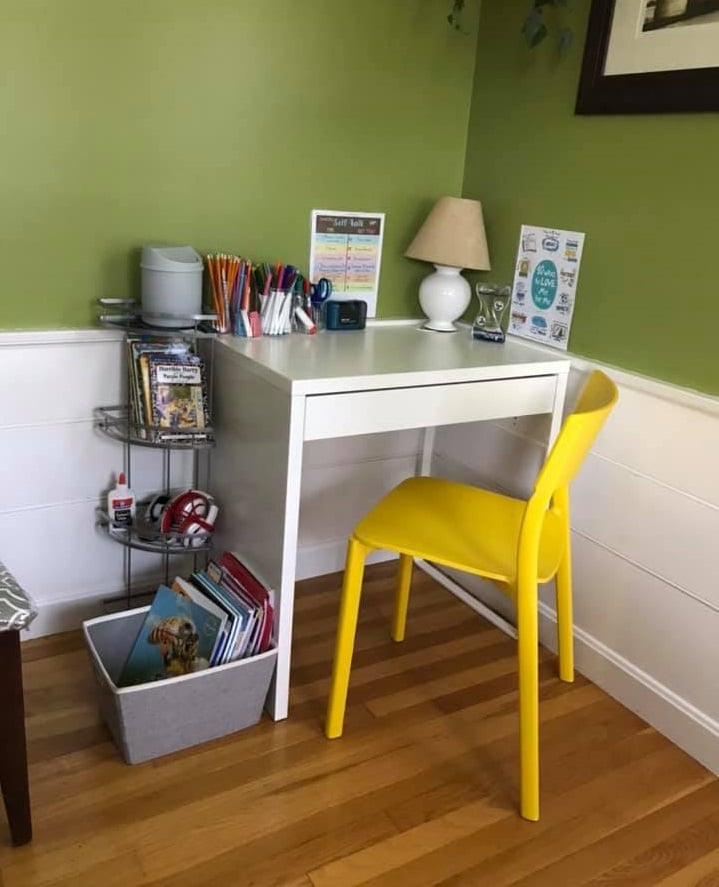
Credit Joanne de Vries
For little ones, Courtney Clerge recommends a STUVA bench, since it's much lower to the ground. It is also currently in stock at Stoughton.
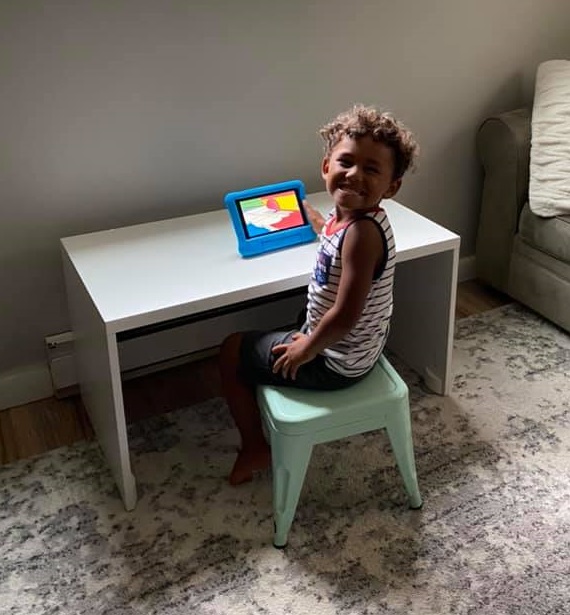
Credit Courtney Clergé
Courtney is a teacher, and she has used the STUVA bench in her classroom both as a small desk and as a cushioned bench. IKEA sells a thin cushion that fits on top but she found a much better and thicker cushion on Amazon -- it's actually a dog bed that fits perfectly!

Credit Courtney Clergé
No need to buy new desks if the budget doesn't allow. Maureen Leo recommends checking Facebook Marketplace, local Buy Nothing groups or yard sales for old desks. Refinish or paint them to give them a fresh new look.
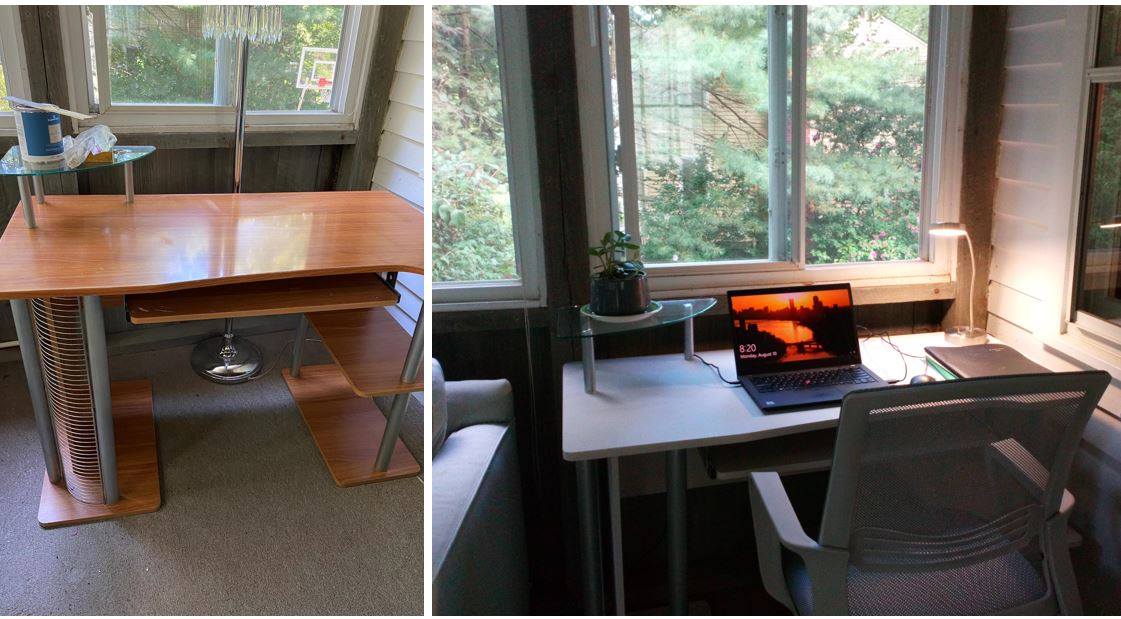
Credit Maureen Leo
Jen Stach repurposed an old entertainment center to create her son's new "Learning Box." "I removed the glass doors from the center compartment on the bottom and took out the shelves to create a kneehole. Then I ordered an LED light fixture and installed that at the top. I also installed a surge protector/ power strip to be easily accessible, as well as a magnetic whiteboard that I already had. There’s storage above that’s easily accessible for daily use materials, and two storage compartments below that can be used for supplies/ bulkier items."
Credit Jen Stach
Credit Jen Stach
Storage, Supplies and Lighting
If the desk you choose doesn't have drawers, consider adding a multi-drawer storage option. IKEA offers the LENNART drawer unit (currently in stock at Stoughton) or Amazon has a fun 10-drawer multicolored rolling cart. If you don't get a multi-drawer cart, you'll need some baskets or bins to hold school supplies, such as pens and pencils, markers and crayons, erasers, calculators, compasses, and headphones or ear buds.
Your child can help you pick out two other key items for their schoolspace: an agenda or calendar and a lamp. Both of these are available at the dollar store or you can find fancier versions at Staples or Target. Let your child pick out their favorite agenda. Maybe it's a desk blotter monthly calendar with tons of space to write assignments, or a fun and unique planner, or maybe even a small dry erase board. This Payne Publishers assignment planner is my daughter's favorite; she used it last year in 10th grade and said it helped her manage her assignments so much better. Lastly, good lighting is key. Be sure there's a task light on your child's desk or a portable one that can be quickly set up in a shared table space.
Special Needs & Healthy Bodies
If your child has sensory or attention issues, it's important to take this into consideration when outfitting their schoolspace. See the tips below from the Massachusetts General Hospital Aspire program:
- Eliminate visual stimuli in the workspace if possible. Examples are colorful books, piles of favorite games, and other distracting items.
- Look into "blue light filters" -- either glasses or screen filters -- if your child is developing a headache after long screen sessions
- Turn off background noises -- music, TV -- and limit conversations. White noise such as the dishwasher, a fan, or a white noise machine may be distracting or, conversely, may be comforting; it's worth testing with your child. Headphones are strongly recommended. Get them with a built-in microphone for Zoom calls.
- Fidget devices can help kids keep fingers busy so they can keep their eyes and brain focused on learning. Have items nearby like squishy balls and common fidget toys, such as an Infinity Cube.
- Figure out an activity your child can do with their feet while they're focusing. Examples include a ball they can roll back and forth. Or tie therabands (stretchy rubber exercise bands) around the base of child's chair for them to gently push and pull with their feet.
- A yoga ball will allow your child to bounce or rock while sitting.
- Oral strategies can help a child focus. Keep mints and gum available, water, or crunchy snacks.
- Encourage your child to run, jump and get outside on regular breaks. If your child needs more frequent breaks, let their teacher know that they will occasionally turn off their video so that they can take a 2-minute activity break and do jumping jacks or jump on a mini trampoline.
- With children on screens for hours a day for learning, try to limit their non-learning screen time.
Suzanne Eaton designed this sensory-specialized schoolspace for her child.

Credit Suzanne Eaton
Lastly, kids need to change positions and maintain good posture if they're sitting for long periods. Take a look at these ergonomic tips for kids from Empowering OT.
I hope these tips help you and your children create a comfortable and effective schoolspace for the upcoming school year!
Macaroni Kid Acton-Concord-Bedford-Lexington is a free weekly newsletter and website focused on fun events and information for local families.
We gather together all kinds of local family events and activities each week, and add useful information about classes, family-focused businesses, book and product reviews, recipes, crafts, school and camp guides and more. We proudly serve thousands of families in Acton, Bedford, Boxborough, Carlisle, Concord, Lexington, Lincoln, Maynard and other surrounding communities.
Subscribe today to receive our email newsletter every Thursday!

